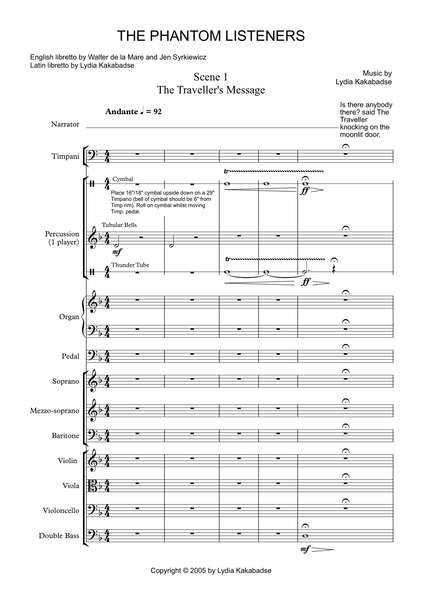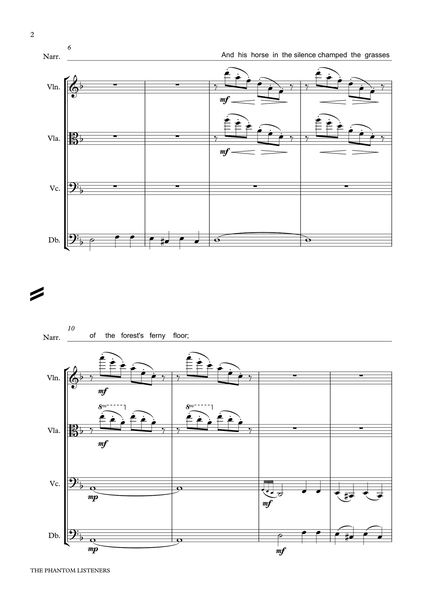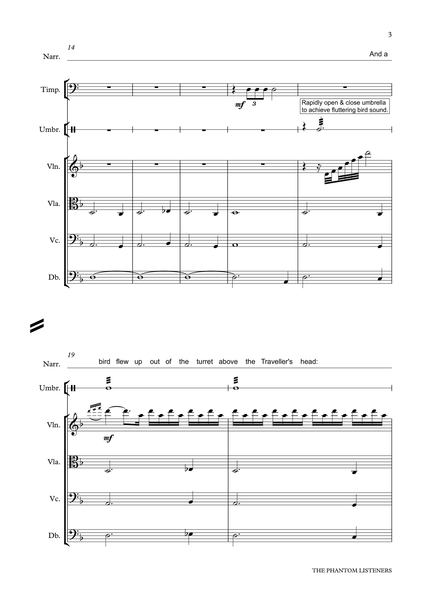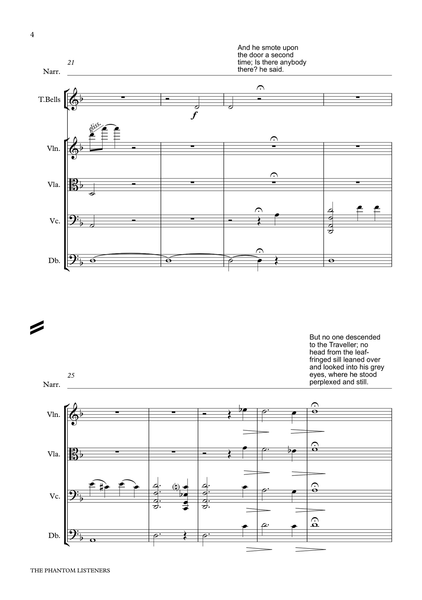Lydia Kakabadse: The Phantom Listeners – for narrator, voices and large ensemble (NXP078)
This is a sheet music edition of The Phantom Listeners by the composer Lydia Kakabadse.
Sheet music for narrator, timpani, percussion*, church pipe organ, soprano, mezzo-soprano, baritone, violin, viola, cello and double bass.
* Percussion:
Tubular bells (C4 to F5)
Thunder Tube or Spring Drum
Umbrella
Tam tam
Triangle
Temple blocks (5)
Tambourine
Side drum
Cymbals (clash and suspended)
English libretto: Walter de la Mare and Jen Syrkiewicz
Latin libretto and translation: Lydia Kakabadse
Duration: 40 minutes
Score: 107 pages
Parts: 57 pages
Parts included are for violin, viola, cello and double bass. The narrator and singers perform from the score as does the percussionist and timpani player. The organ plays intermittently only and also plays from the score.
Please bear this in mind when ordering performance materials.
Audio Samples
Preface and programme notes
The idea of creating a musical drama inspired by Walter de la Mare’s poem The Listeners started to take shape in 2005. I decided from the outset to write the words in Latin for the soprano, mezzo-soprano and baritone voices (which collectively represent the phantom listeners) and chose to have the narrative spoken rather than sung. The strings make up the core instrumental accompaniment, to which are added a wide range of percussion instruments and church pipe organ. Whilst the piece is not scored for wind instruments, a flute sound is achieved by way of the organ flute stop. I was striving to achieve an eerie, haunting and mysterious effect in keeping with the words and the piece therefore makes much use of parallel organum and strings playing in their lower register, as well as chanting and selective use of percussion and the organ. The use of Latin words adds to the overall effect.
The Phantom Listeners was created originally as a setting of The Listeners to music – premiered at Ely Cathedral in April 2006 – and was then to become the first scene of a much-extended piece. In the summer of 2006, I collaborated with Jen Syrkiewicz, who worked on extending the narrative in verse. As I wanted a circular story so that the narrative ends in the way it began, Jen added 4 scenes, the final one of which dovetails into a curtailed version of the first scene. The Phantom Listeners was completed in March 2007 and premiered at St John’s Smith Square, London the following March. The work has been recorded on the Naxos label and is included in my album The Phantom Listeners.
I The Traveller’s Message
The Traveller unsuccessfully tries to obtain a response from a house inhabited by the Phantom Listeners, who strongly oppose his presence. Tubular bells and the sound of thunder dramatically set the scene followed by the introduction of a haunting theme on the double bass. The organ’s dramatic and discordant entry late in this scene is closely based on Bach’s Toccata and Fugue in D minor. Before departing from the house, the Traveller leaves a message.
II Secrets of the House
Events leading up to the Traveller’s arrival at the house unfold. On the orders of an evil witch, the Phantom Listeners hold a maiden captive in the house and watch over her day and night. The maiden, who is betrothed to the Traveller, lies in a death like sleep under the witch’s curse. In antiphonal style singing, the Phantom Listeners rejoice that the curse will continue for eternity and will never be broken.
III The Traveller Returns
The Traveller wanders aimlessly pondering the words of the curse and when at last he succeeds in deciphering the riddle, he resolutely rides back to the house. First without accompaniment and then with sparse string accompaniment, the Phantom Listeners meanwhile joyfully proclaim that if they guard the maiden diligently, they will be well rewarded. The mood changes when the Traveller approaches the house.
IV The House Rages
Realising that the Traveller has succeeded in breaking the curse, the Phantom Listeners flee. The Traveller forces his way into the house and when he sees his beloved, the mood becomes mournful, culminating in both losing their lives. When the Phantom Listeners return to the house, they turn against the witch, whom they blame for the maiden’s death. Absorbing strange powers released from the spell, the house erupts into a rage entrapping the witch.
V Reunited
The first part of this scene is happy and joyful as the two lovers are happily reunited. They rejoice at their good fortune and are married amid much celebration. The second part is dark and sinister – created by basso ostinato cello/double bass and discordant organ – depicting the house holding The Phantom Listeners captive. Their ominous chanting penetrates through the dark eerie night.
Epilogue
A young traveller knocks on the door of the haunted house. Mindful that this young traveller may be their saviour and therefore able to break the spell, the Phantom Listeners beg him to enter their house and remain there. They declare that he belongs to their shadowy world and should not go back to the world of men.
Lydia Kakabadse




















